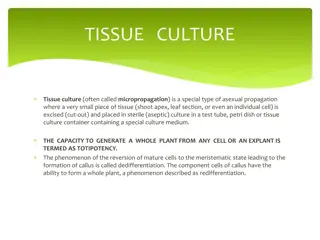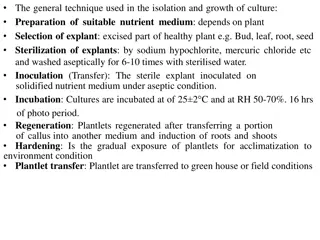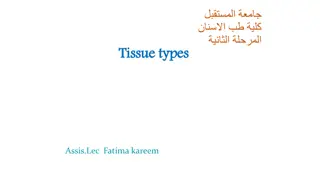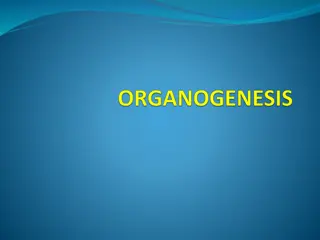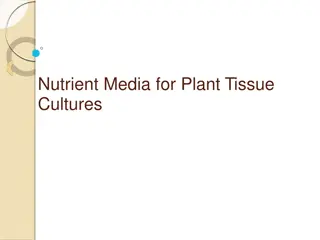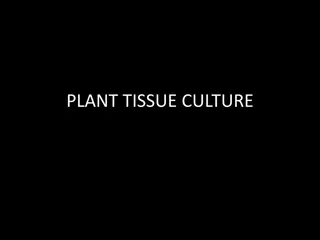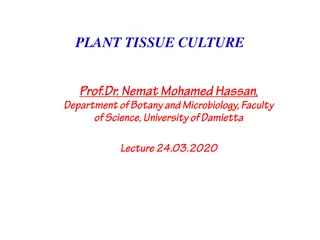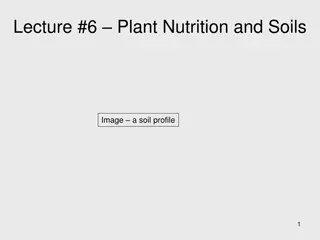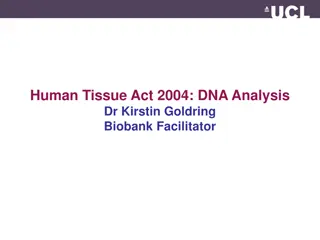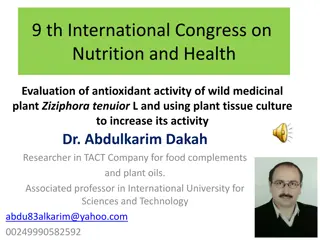Plant Tissue Culture Techniques and Types Explained
Plant tissue culture involves the isolation and growth of plant cells in a controlled environment. The process includes preparation of nutrient medium, selection and sterilization of explants, inoculation on a solid medium, incubation, regeneration of plantlets, and transfer for hardening and growth. Different types of plant tissue cultures, such as Root Tip Culture and Leaves/Leaf Primordia Culture, serve various purposes in studying cell division, growth conditions, and development.
Download Presentation

Please find below an Image/Link to download the presentation.
The content on the website is provided AS IS for your information and personal use only. It may not be sold, licensed, or shared on other websites without obtaining consent from the author. Download presentation by click this link. If you encounter any issues during the download, it is possible that the publisher has removed the file from their server.
E N D
Presentation Transcript
Basic Methodology/technique of Plant Tissue Culture & Type of Tissue culture
The general technique used in the isolation and growth of culture: Preparation of suitable nutrient medium: depends on plant Selection of explant: excised part of healthy plant e.g. Bud, leaf, root, seed Sterilization of explants: by sodium hypochlorite, mercuric chloride etc and washed aseptically for 6-10 times with sterilised water. Inoculation (Transfer): The sterile explant inoculated on solidified nutrient medium under aseptic condition. Incubation: Cultures are incubated at of 25 2 C and at RH 50-70%. 16 hrs of photo period. Regeneration: Plantlets regenerated after transferring a portion of callus into another medium and induction of roots and shoots Hardening: Is the gradual exposure of plantlets for acclimatization to environment condition Plantlet transfer: Plantlet are transferred to green house or field conditions
Preparation of an explant Inoculation After incubation Selection of plant Various stages of plant growth Plant ready to be transferred into green house or hardening stage Regeneration of a plant from an explant 25
Laminar air flow Tissue culture rack 26
TYPES OF PLANT TISSUE CULTURES based on part used Root Tip Culture (Meristem root tip culture) Function of Root apical meristem: Cell division/differentiation/ enlargement Tips of the lateral roots are sterilized, excised and transferred to fresh medium. The lateral roots continue to grow and provide several roots, which after seven days, are used to initiate stock or experimental cultures. Thus, the root material derived from a single radicle could be multiplied and maintained in continuous culture; such genetically uniform root cultures are referred to as a clone of isolated roots. Possible to study the nutritional requirements of roots, shoot and root growth, conditions required for the development of secondary vascular tissues, lateral root and bud formation, nodulation etc.
Leaves or Leaf Primordia Culture Leaves (800 m) detached from shoots, surface sterilized and placed on a solidified medium where they remains in a healthy conditions for a long periods. Growth rate in culture depends on its stage of maturity at excision. Young leaves have more growth potential than the nearly mature ones. Shoot Tip Culture The excised shoot tips (100 1000 m long) of many plants species can be cultured on simple nutrient media, with growth hormones and form roots and develop into plants. Virus free species: potato, sugarcane, rhubarb. Used for both monocot and dicot plants
Complete Flower Culture By Nitsch in 1951 Culture of the flowers of dicotyledonous species; The flowers remain healthy and develop normally to produce mature fruits. Used to study microclimates or nutritional effects on the vegetative and reproductive processes of the plant. Flowers (2 days after pollination) are excised, sterilized by immersion in 5% calcium hypochlorite, washed with sterilized waterand transferred to culture tubes containing an agar medium. The fruits that develop are smaller than natural ones, size can be increased by supplementing the medium with growth hormones.
Anther and Pollens Culture Young flower buds removed from the plant and surface sterilized. The anthers carefully excised and transferred to nutrient medium. Immature stage usually grows abnormally and there is no development of pollen grains from pollen mother cells. Anther at a very young stage (containing microspore mother cells or tetrads) and late stage (containing binucleate starch-filled pollen) of development are generally ineffective, therefore select mature anther or pollen. Mature anther or pollen grains of gymnosperms can be induced to form callus by spreading them out on the surface of a suitable agar media. Mature pollen grains of angiosperms do not usually form callus, with few exceptions. Pollen grains removed from the anther either mechanically or by natural dehiscence. Anthers placed in 5 ml of liq medium in a petri dish containing pollen grains in the culture media, sealed with parafilm and incubated. After incubation haploid plantlets are developed.
Ovule and Embryo Culture Embryo is dissected from the ovule and put into culture media. Very small globular embryos require balanced hormones. Hence, mature embryos are excised from ripened seeds and cultured to avoid inhibition in the seed for germination. Is relatively easy, requires simple nutrient medium containing mineral salts, sugar and agar for growth and development. The seeds treated with 70% alcohol for about 2 min, washed with sterile distilled water, treated with surface sterilizing agent for specific period, once again rinsed with sterilized distilled water and kept for germination by placing them on double layers of presterilized filter paper placed in petridish moistened with sterilized distilled water or placed on moistened cotton swab in petridish. The seeds are germinated in dark at 25 28 C and small part of the seedling is utilized for the initiation of callus. dormancy period of seeds can be shortened & production of haploids By ovule culture, possible to grow, study various nutritional requirements and stages young embryos or zygote.
Ovary culture Ovaries excised after pollination can produce fruits on a simple medium containing mineral salts, sugar and vitamins. Ovaries taken from un-pollinated flowers fail to produce fruits on a simple medium but can develop into seedless fruits on a medium supplemented with hormones. By this method, physiology of fruit development can be studied. Haploids can be produced. Rare hybrids can also be produced by ovary culture. Dormancy period of seeds can be reduced
Seed culture The seeds are treated with 70% alcohol for about two minutes, washed with sterile distilled water, treated with surface sterilizing agent for specific period. Once again rinsed with sterilized distilled water and kept for germination by placing them on double layers of presterilized filter paper, placed in petri-dish moistened with sterilized distilled water or placed on moistened cotton swab in petri-dish. The seeds are germinated in dark at 25-28 C and small part of the seedling is utilized for the initiation of callus.
Hairy Root Culture By Steward et al. (1900). A large number of small fine hairy roots covered with root, hairs originate directly from the explant in response to Agrobacterium rhizogenes infection are termed hairy roots. These are fast-growing, highly branched adventitious roots at the site of infection and can grow even on a hormone-free culture medium. Many plant cell culture systems, which do not produce adequate amount of desired compounds, are being reinvestigated using hairy root culture methods. A diversified range of plant species has been transformed using various bacterial strains. One of the most important characteristics of the transformed roots is their capability to synthesize secondary metabolites specific to that plant species from which they have been developed. Growth kinetics and secondary metabolite production by hairy roots is highly stable and are of equal level and even they are higher to those of field grown plants solid and in liquid media
ESTABLISHMENT AND MAINTENANCE OF VARIOUS CULTURES 3 main culture systems, selected on the basis of the objective. 1. Growth of callus masses on solidified media (callus culture also known as static culture). 2. Growth in liquid media (suspension culture) consistsof mixture of single cells or cell aggregates. 3. Protoplast culture: Callus culture (static tissue culture) orSuspension culture
Callus Culture Callus is an amorphous aggregate of loosely arranged parenchyma cells, which proliferate from mother cells. Cultivation of callus on a solidified nutrient medium under aseptic conditions is known as callus culture A. Initiation of callus culture (SP,CM,T,I,M) 1. Selection and preparation of explant :organ or culture is selected such as segments of root or stem, leaf primordia, flower structure or fruit, etc. Excised part washed with tap water sterilized 0.1% HgCl2 or 2% NaOCl,15 min. detergent to sterilization solution to reduce water repulsion wash with sterile glass D water cut to small segments (2-5mm) aseptically
Callus Culture 2. Selection of culture medium: Depends on species of plant & Objective Well-defined nutrient medium- inorganic and organic nutrients and vitamins. MS Medium : conc. Of NO3, K, NH4 for dicot tissues Growth hormones (auxin, cytokinin) Auxins, IBA and NAA for rooting + cytokinin for shoot proliferation. 2, 4-D and 2, 4, 5-T for good growth of the callus culture. Favourable for monocot tissues or explant. Selected semisolid nutrient is prepared. pH of the medium (5.0 6.0) Poured into culture Vessels (15 ml for 25 x 150 mm culture tubes or 50 for 150 Ml flasks) plugged and sterilized by autoclaving.
Callus Culture 3. Transfer of explant Surface sterilized organs (explant) vessel (semisolid culture medium) 4. Incubation of culture Inoculated vessels BOD incubator, Incubate at 25 28 C, light and dark cycles for 12-h duration. Nutrient medium is supplemented with auxin to induce cell division. 3-4 weeks callus (five times the size of the explant) Commercially important secondary metabolites can be obtained from static culture by manipulating the composition of media and growth regulators (physiological and biochemical conditions), but on the whole it is a good source for the establishment of suspension culture.
Callus Culture Callus is formed through three stages of development Induction , Cell division andCell differentiation(ICC) 1. Induction metabolic activities of the cell increase; cell accumulates organic contents and finally divides into a number of cells. The length of this phase depends- functional potential of the explant and the environmental conditions of the cell division stage. 2. Cell division This is the phase of active cell division as the explant cells revert to meristematic state. 3. Cell differentiation This is the phase of cellular differentiation, i.e. morphological and physiological differentiation occur leading to the formation of secondary metabolites.
Callus Culture 5. Maintenance (Sub culturing) After sufficient time of callus growth on the same medium Depletion of nutrients, loss of water, accumulationof metabolic toxins. To maintain of growth in callus culture sub-culture of callus in fresh medium. Healthy callus tissue of sufficient size (5 10 mm in diameter) and weight 20 100 mg) is transferred under aseptic conditions to fresh medium, sub-culturing repeated after 4-5 weeks. Many callus cultures remain healthy & grow at slow rate for longer period without sub-culturing also if incubation is done at low temperature (5 10 C) Normally, total depletion takes about 28 days.
Callus Culture- Color of callus White: If grown in dark due to the absence of chlorophyll Green: If grown in light Yellow: Due to development of carotenoid pigments in greater amounts Purple: Due to the accumulation of anthocyanins in vacuole Brown: Due to excretion of phenolic substance and formation of quinones
Suspension Culture Contains a uniform suspension of separate cells in liquid medium. To prepare suspension culture, callus fragments to liquid medium (without agar) agitated in rotary shaker (50-150 rpm) to keep the cells separate sufficient number of cells subculturing in fresh liquid medium. Single cells can also be obtained from fresh plant organ (leaf). Initiation of suspension culture (a) Isolation of single cell from callus culture: Healthy callus tissue petridish on a sterile filter paper , cut to pieces with sterile scalpel Selected piece of callus 300 500 mg into flask with 60 ml of liquid nutrient media no gelling agent agitation at 50 150 rpm to separate cells Decant medium, resuspend residue by slowly rotating the flask transfer 1/4th of the entire residue to fresh medium, followed by sieving the medium to get uniformity of cells.
Suspension Culture (b) Isolation of single cell from plant organ: From the plant organ (leaf tissue) single cell isolation: Mechanical method Enzymatic method Mechanical method: surface sterilized fresh leaves grinded in (1:4) (20 mol sucrose; 10 mol MgCl , 20 mol tris-HCl buffer, pH 7.8) in glass pestle mortar homogenate passed muslins cloth washed with sterile D H2O centrifuged with culture medium sieved placed on culture dish for inoculation
Suspension Culture Enzymatic method: Leaves from 60- to 80-day-old plant sterilized in 70% ethanol in hypochlorite solution washed sterile DD water on sterile tile, peel off lower surface with sterile forceps cut into small pieces (4 cm) Transfer (2 g leaves) to flask (100ml) containing 20 ml filtered sterilized enzyme solution (macerozyme 0.5% solution, 0.8% mannitol and 1% potassium dextran sulphate) Incubate at 25 C for 2 h (change the enzyme solution with the fresh one at every 30 min) wash the cell twice with culture medium place them in culture dish.
Curve showing the growth pattern in the suspension culture 1. Lag phase: Period where the cells adjust themselves to the nutrient medium and undertake all the necessary synthesis prior to cell division. 2. Logarithmic phase or exponential phase: Very rapid cell division , logarithmic increase in cell number 3. Linear phase : Rapid cell division results in a linear increase in number 4. Stationary phase : As nutrients are depleted and some of the cells of the culture being to show senescent characteristics, the rate of cell division within the culture declines and it passes through the stationary phase.
Parameters for measuring growth of cultured cells 1. Cell Fresh weight: can be determined by collecting cells on a pre- weighed (in wet condition) circular filter of nylon fabric supported in a funnel, washing the cells with water to remove the medium, draining under vacuum, and reweighing. 2. Cell Dry weight: pre-weighed dry nylon filter and after collecting the cells on the filter dry them for 12 h at 60 C and reweigh. Cell weight is expressed as per culture or per 106 cells. 3. Packed cell volume (PCV). Transfer a known volume of uniformly dispersed suspension to a 15-ml graduated centrifuge tube and spin at 200 rpm for 5 min. PCV is expressed as ml pellet/ m1 culture. 4. Cell counting: cell colonies are of various sizes. Specific procedure is followed. 1 volume of culture + 2 volumes of 8% chromic trioxide, heat to 70 C for 2-15 min. Cool, and shake vigorously for 10 min before counting the cells in a haemocytometer.
Assessment of viability of cultured cells 1. Phase contrast microscopy: based on cytoplasmic streaming and the presence of a healthy nucleus 2. Reduction of tetrazolium salts. respiratory efficiency of cells is measured by reduction of 2,3,5-triphenyltetrazolium chloride (TTC) to the red dye formazan. Formazan can be extracted and measured spectrophotometrically. 3. Fluorescein diacetate (FDA) method: Stock solution of FDA at a concentration of 0.5% prepared in acetone, stored at 0 C. To test viability, add to the cell or protoplast suspension at a final concentration of 0.01%. Incubate for 5 min, examine the cells under mercury vapour lamp. FDA is non-fluorescing and non- polar, and freely permeates across the plasma membrane. Inside the living cell it is cleaved by esterase activity, releasing the fluorescent polar portion fluorescein. Since fluorescein is not freely permeable across the plasma membrane, it accumulates mainly in the cytoplasm of intact cells, but in dead and broken cells it is lost. When illuminated with UV light it gives green fluorescence.
Maintenance Suspension culture Continuous culture Volume of culture is constant Semicontinuous culture Open system periodic removal of culture & addition of fresh medium Batch culture Cells allowed to multiply, agitated to break cell aggregates, Cells transferred to fresh medium - Batch Open Type Closed Type Turbidostat Chemostat
Protoplast Culture Protoplasts are the naked cells of varied plant origin without cell walls, which are cultivated in liquid as well as on solid media. Protoplasts can be isolated by mechanical or enzymatic method from almost all parts of the plant: roots, tubers, root nodules, leaves, fruits, endosperms, crown gall tissues, pollen mother cells and the cells of the callus tissue but the most appropriate is the leaves of the plant. Fully expanded young leaves from the healthy plant are collected, washed with running tap water and sterilized by dipping in 70% ethanol for about a minute and then treated with 2% solution of sodium hypochlorite for 20 30 min, and washed with sterile distilled water to make it free from the trace of sodium hypochlorite. The lower surface of the sterilized leaf is peeled off and stripped leaves are cut into pieces (midrib). The peeled leaf segments are treated with enzymes (macerozyme and then treated with cellulase) to isolate the protoplasts.
Protoplast Culture The isolated protoplasts cleaned by centrifugation and decantation method. Then the protoplast solution of known density (1 105 protoplasts/ml) is poured on sterile and cooled down molten nutrient medium in petridishes. Mix the two gently by quickly rotating each petridish. Allow the medium to set and seal petridishes with paraffin film. Incubate the petridishes in inverted position in BOD incubator. The protoplasts, which are capable of dividing undergo cell divisions and form callus within 2 3 weeks. The callus is then sub-cultured on fresh medium. Embryogenesis begins from callus after transferring to a medium with auxin and cytokinin, where the embryos develop into plantlets which may be transferred to pots
Nutritional Requirements vary with the species, Trial and error basis Gautheret (1942), White (1943), Haberblandt etal. (1946), Haller (1953), Nitsch and Nitsch (1956), Murashige and Skoog (1962), Eriksson (1965) and B5 (Gamberg et al., 1968) To maintain the vital functions of a culture, the basic medium consisting inorganic nutrients (macronutrients and micronutrients) organic components (amino acids, vitamins), growth regulators (phytohormones) utilizable carbon (sugar) source gelling agent (agar/phytogel)
Nutritional Requirements inorganic nutrients (macronutrients and micronutrients) Macronutrients: The macronutrients include six major elements: N, P, K, Ca, Mg and S as salts. Concentration of Ca, P, S Mg 1 3 mmol/l, N 2 20 mmol/l. Micronutrients: required in trace qty. but essential, B, Cu, Fe, Mn, Zn and Mo. In addition, Co, I2 and Na. Organic nutrients Nitrogenous substances: thiamine (vitamin B) pyridoxine (vitamin B6), nicotinic acid (vitamin B3) and calcium pentothenate (vitamin B5) and ionositol Complex nutritive mixtures of undefined composition- casein hydrolysate, coconut milk, corn milk, malt extract, tomato juice and yeast extract promotes growth Carbon Source: utilizable source of carbon: sucrose at a concentration of 2 5%. Glucose and fructose, maltose, galactose, mannose, lactose, sorbitol, starch etc. Dicotyledonous roots grow better with sucrose where as monocots do best with dextrose (glucose).
Plant growth regulators Auxins: cell division and cell growth: chemical analogues of IAA, 2,4-Dichlorophenoxyacetic acid (2,4-D) is the most commonly used auxin Cytokinins: promote cell division: zeatin and 2iP (2-isopentyl adenine) natural, synthetic analogues, kinetin and BAP (benzylaminopurine) Gibberellins: cell elongation, agronomically important in plant height and fruit set. GA3 being the most common. Abscisic acid: inhibits cell division, used to promote distinct developmental pathways such as somatic embryogenesis Solidifying agents for solidification of the media improved oxygen supply and support to the culture growth agar agar 0.8 1.0%, (Ca, Mg, K, Na and trace elements as impurities) Agar (Agarose) resistant to enzymatic hydrolysis
pH of the medium adjusted between 5.0 and 6.0 before sterilization. pH higher than 6.0 gives hard medium and pH below 5.0 does not allow satisfactory gelling of the Agar. 2 methods of preparation of media: (i) weigh the required qty of nutrient, dissolve separately & mix at the time of medium preparation. (ii) Prepare the stock solution separately for macro-nutrients, micro- nutrients, iron solution and organic components, store in the refrigerator till not used e.g. Murashige and Skoog s media stock solution Group I: 20x concentrated solution Group II: 200x Group III Iron salts at 200x Group IV organic ing. except sucrose 200x
Stock Solution preparation (1 or 10 mmol l-1) Each component - weigh, dissolve separately DD H2O, stored in refrigerator till used. For Fe solution, dissolve FeSO4 7H2O and Na2EDTA2H2O separately in 450 ml dis. H2O by heating and stirring. Mix the 2 solutions, adjust pH to 5.5 and adjust vol. to 1 L with dis. H2O Semisolid media preparation Agar and sucrose weighed, dissolved in H2O by heating on water bath. Req. quantities of stock solution (for 1L: 50 ml of stock solution of Group 1, 5 ml of stock solution II, III and IV group) and other special supplements are added and final volume is made up with DD H2O After mixing well, pH of the medium is adjusted to 5.8 using 0.1 N NaOH and 0.1 N HCl.
Sterilization of Culture Media Pack culture media, seal with cotton, cover with Al foil, autoclave at 2-2.2 atm press. At 121 C, 15-40 min (time to be fixed from the time when temperature reaches the required temperature). The exposure time depends on the volume of the liquid to be sterilized.






